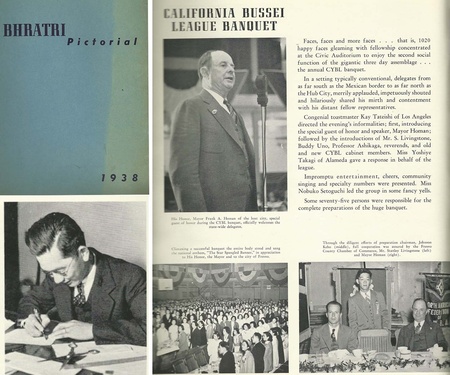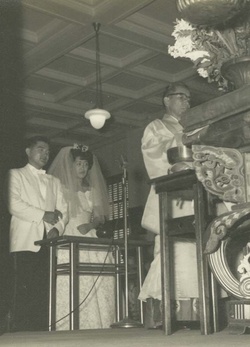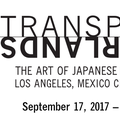When I was nine years old, the Sunday ritual was to drive the five miles or so from our home in Tarpey Village in Clovis until we were out where long dirt driveways led to vineyards and farmer homes, where a single oak tree shaded a tiny, unmarked bungalow. Steel grey folding chairs were brought from the closets and the children were instructed to plunk zabuton on each chilly metal seat, candles and thin green rods of incense were lit, as an overhead heater roared to life. That tiny bungalow was where I attended weekly dharma school and even played “Hotoke Sama” on the piano for our very small Buddhist congregation who lived out in the sticks; Sunday School for the outlying areas such as Fowler, Madera, Selma, Dinuba, Kingsburg, and Parlier.
I live in Los Angeles now. As news that the historic Jodo Shinshu Buddhist temple located in downtown Fresno was up on the auction block reached the southern California Japanese American community, colleagues began leaving me both physical and digital copies of an article that was published in the Los Angeles Times on August 1, 2011—in the heat of the annual obon season.
Being a semi-native Fresnan (I was born in San Diego and raised for the first seven years in Honolulu, but lived in the Fresno area from age eight until seventeen), I was asked for my candid opinion about the temple everywhere I went: over dinner, in the hallways at work, and on my Facebook page. But as the initial spell of dismay over the abandonment of the old for the new washed through the network, I realized what a tremendous piece of my identity as a Japanese American was formed by that very temple and by being raised Buddhist in the Central Valley.
Fresno, like so many mid-sized American cities, has expanded expotentially since it was first incorporated in 1847. What were once thriving ethnic enclaves scattered around a downtown base bordering the newly laid Southern Pacific Railroad line has now grown a thousand fold in circumference, as people built outwards from the original central core (where transportation and commerce was once the hub), conjuring up cheaper housing and the mini-malls by the hundreds to support its growing suburban populations. What is left behind in the downtown district is then left to decay.
This story is similar in some ways, but of course different from what happened in Little Tokyo with the Los Angeles Hompa Hongwanji Temple on the corner of 1st and Central street, which happens to be a sister temple to the one in Fresno.
In the mid 1950s, the L.A. Hompa Hongwanji, (affectionately known by locals as Nishi Hongwanji) having outgrown the temple that their Issei congregation built in 1925, launched an ambitious fundraising effort to build a new and larger temple further down 1st street to Vignes and subsequently sold their old temple to the City of L.A. The original Nishi temple, like the Fresno church, was a physical testament to Issei fundraising acumen and a manifestation of their determination to put their hard-earned capital into a more productive way of living while remaining on American soil.
From the stories I’ve heard, Little Tokyo and downtown Los Angeles in general suffered during the war years by the two-pronged forced incarceration of the Japanese and the arrival of African Americans, Mexicans, and others who were lured to California by offers of work in the US defense industry. This rush of migration resulted in crowded, squalid conditions in the aging historic districts, which is what the Japanese Americans returned to in 1945. As the community struggled to find some sense of normality in their lives in the traumatic years following war, Nishi Hongwanji, in both its physical and spiritual form, sheltered dozens of homeless families and provided the foundation on which the community slowly began to rebuild. By the mid-1950s, the congregation had swelled back to its pre-war numbers and beyond as the Nisei generation reached its marriage and child-bearing peak.
Simultaneously with (although most likely not in consideration of) the temple’s plans for possible relocation, the Los Angeles Redevelopment Commission had its eye on the entire swath of buildings that flanked Nishi Hongwanji, as city plans emerged in 1963 to tear down the so-called decrepit buildings and widen 1st Street. So when decision to rebuild the temple were official ten years later, the City of Los Angeles purchased the historic building, which surely had a part in helping raise funds for the new temple on Vignes.
The street widening along 1st Street never happened (I’m not sure why), and thus, the former Nishi building was left standing. There may have been brief periods of habitat, but to my knowledge, the historic building was by and large empty for decades. In the meantime, a resurgence of Japanese American cultural traditions such as Nisei Week and the opening of other nonprofits nearby such as the Japanese American Cultural and Community Center and East West Players in the old Union Church building helped establish Little Tokyo as a vibrant, living community once again.
Fresno did not have this same experience. While the population of Fresno proper soared in the second half of the 20th century and continues to experience dramatic increases into the 21st century, downtown continues to suffer. In 1992, Fresno City Hall itself moved out of the heart of downtown, re-envisioning itself as a futuristic neo-architectural swoop on the edge of downtown.
I first heard of the new/old Buddhist temple quandry about a year and a half ago, when I found out that my family had donated funds towards the new temple. It isn’t sheer coincidence that the proposed new Buddhist temple will be built on a swath of land out by Clovis that, if the stories I’ve heard are accurate, is land that the Buddhist community purchased decades ago, perhaps with this kind of shift in mind.
This area was once all grapevines, fig orchards, strawberry fields, and cow pastures, but today it is filled with tract houses lined by advertising banners that whip in the wind and achingly new elementary schools. It’s where the new generations of Japanese American community lives. It is a mere stone’s throw from where that lone oak tree and the tiny Buddhist bungalow I practiced in once stood.
I felt a terrible yearning for the old Fresno Betsuin Buddhist temple when I heard that it might be replaced, and that sense of nostalgia has slowly eaten away my heart. Like so many other generations of Japanese Americans from the valley, our central identity was rooted in the old temple on the corner of Kern and E Streets, and with little effort my mind was flooded with memories of the numerous funeral services, Hanamatsuri, and especially the annual Obon festivals, when stopping in at Komoto’s Department Store and Central Fish were all part of an organic experience of visiting West Fresno.
Granted, much of those Buddhist services were actually exercises in controlling our gasps of air and giggles when the sound of unearthly priests chanting in incomprehensible Japanese struck our dumb Yonsei ears. Yet it was sorrow I felt, that certain kind of mourning, upon realizing the end of a previously unbroken line of history. Up until now, every single couple in my family had been married at that temple; in fact, my maternal grandfather, Johnson Kebo, was even the temple board chairman in 1956. (Johnson married Miyeko Okamura on July 18, 1938 at the Fresno Betsuin Temple, which was a double wedding with Johnson’s younger brother George and his wife Evelyn. I even investigated getting married there this past May, but opted to have the ceremony at a Buddhist temple in Los Angeles.)

My maternal grandfather, Johnson Kebo. I came across this awesome publication from 1938 and scanned a few pages--he eventually served as president of the temple, but in 1938 was one of the advertising directors, Central Valley for the annual publication, plus there's a picture of him looking patriotic and stuff with the mayor of Fresno.
But the inherent reality of the congregation’s 21st century needs became apparent when I was asked to participate in the ribbon-cutting ceremony for the new Buddhist “Dharma Family Center” last spring. The Dharma Family Center is a spanking new gymnasium/community center that is currently standing in for the temple services while the new one is being constructed adjacent to the gym. I certainly couldn’t refuse. I arrived with the rest of the family, and as I saw dozens of tables groaning with tupperware dishes and watched row upon row of chairs fill with three generations of Central Valley Buddhists, it dawned on me. Man, everyone here is so over it!
What is alive in Fresno today isn’t something held to a fixed point on the map or even housed within sacred walls. The needs for ritual and to teach tolerance and humility, and well…even the need for basketball gyms and potlucks in a place where people conveniently congregate—that is where the community thrives. I was one of many people that day who held a pair of scissors and symbolically snipped the ribbon at the ceremonial breaking of new ground. It genuinely moved me to witness this transition, even as I stood behind a row of Nisei, Sansei, and Yonsei, whose families had undoubtedly contributed to our way of life and whose shoulders we were standing upon that day.
To acknowledge the well-intentioned appeals by preservationists and historical monument supporters, I know that objects steeped in memory are the artifacts we seek out for telling stories. The temple has tremendous power as a historical site of conscience and has hundreds of entry points for reflecting our community’s history, having borne witness to decades of community life, especially when it carried the weight of the Japanese forcibly ousted from the once crowded West Fresno neighborhood in 1943. Yet for all of the value we place on the Fresno temple’s marble stairs which we all walked up, and the 3,000 lb. bronze bell that carried our prayers, perhaps that weight, those seemingly permanent structures are not what they simply appear to be. Isn’t that what Buddhism teaches us, to lose our attachment to earthly belongings, and that all things are impermanent? To not hold on?
So what is the elegant solution to this most complex personal / community / economic / spiritual conundrum? Perhaps the old Fresno Betsuin Buddhist Temple could be purchased and moved across town as some people are suggesting. But is there another way of thinking about the tenets of honoring ancestors and impermanence? Maybe the old temple can be converted into something like a center for alternative medicine to heal the homeless population that now camp beneath its cloud-shaped gates or into a legal center to represent the myriad immigrants that still pour into the valley everyday, searching for work and a home and a strategy for survival. Do not do any evil and cultivate good, the old temple reminds us. Which brings me to the last part of my story in relating the history of the L.A. Nishi Hongwaji temple with the experience we are living today in Fresno. After lying fallow for nearly twenty years, the historic Nishi Hongwanji building was riddled with holes and bore the worst evidence of neglect. It wasn’t until 1987 that the unimaginable happened and the future of the temple was revived. On that year, the City of L.A. signed a lease with an emerging non-profit to open a national museum dedicated to the history and experience of Japanese Americans. Exercise and honor the power of a community’s strength and perhaps someday we can make the beloved home another home for others.
© 2011 Patricia Wakida






